Theories, Models, and Principles in Education and Training: A Report
VerifiedAdded on 2023/02/01
|20
|5063
|499
Report
AI Summary
This report provides a comprehensive overview of various learning theories, including behaviorism, cognitivism, and humanism, as well as models of learning preferences such as Gibbs's and Kord's. It explores how these theories and models can be applied to teaching, learning, and assessment, with a focus on creating inclusive educational environments. The report also delves into communication models, such as transactional analysis, interactive communication, and linear communication, and their application in educational settings. Furthermore, it discusses assessment principles like validity, authenticity, and fairness, and their practical implementation. The document also includes the application of Bloom's taxonomy of learning. The report aims to equip educators with the knowledge and tools necessary to enhance their teaching practices and create effective learning experiences.
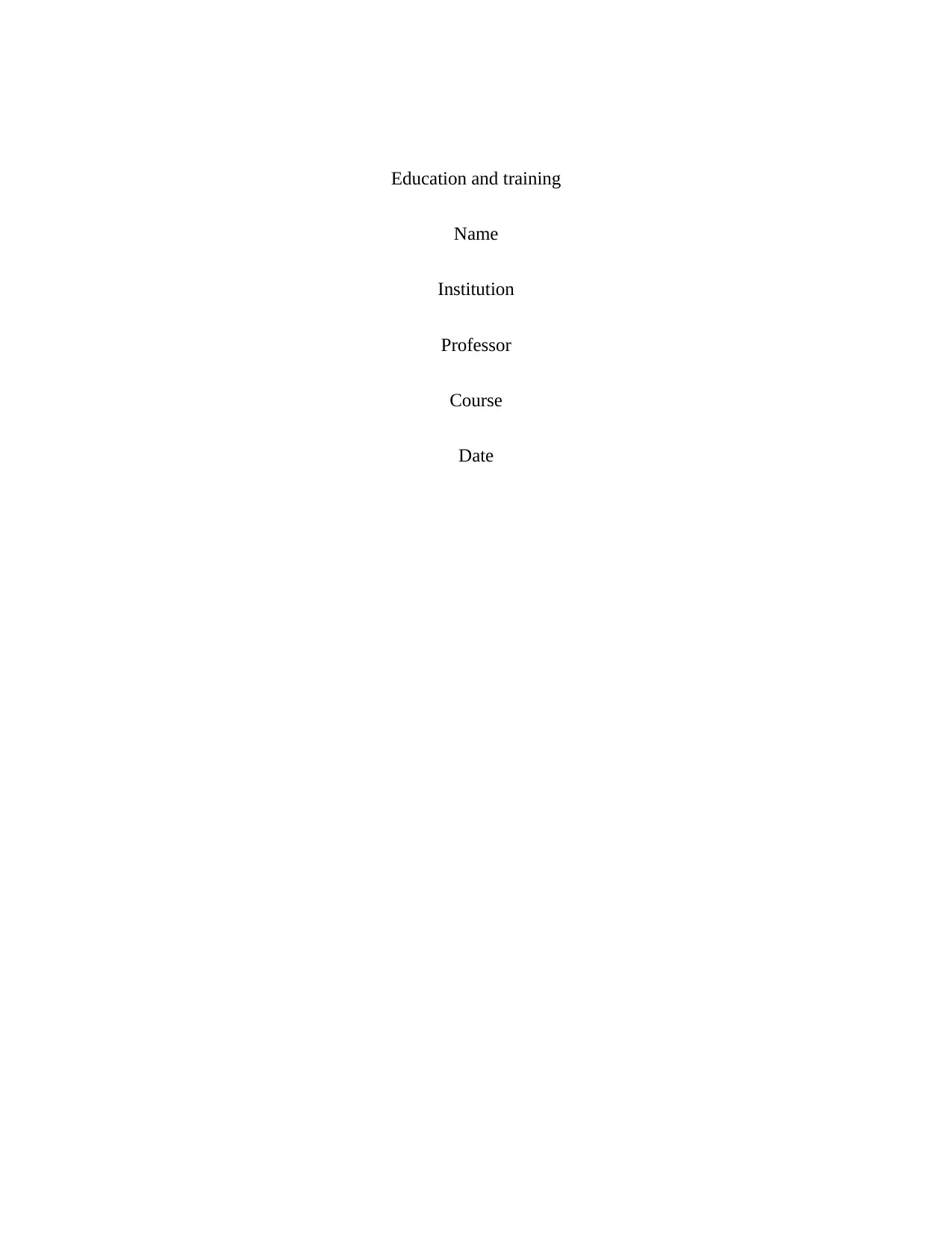
Education and training
Name
Institution
Professor
Course
Date
Name
Institution
Professor
Course
Date
Paraphrase This Document
Need a fresh take? Get an instant paraphrase of this document with our AI Paraphraser
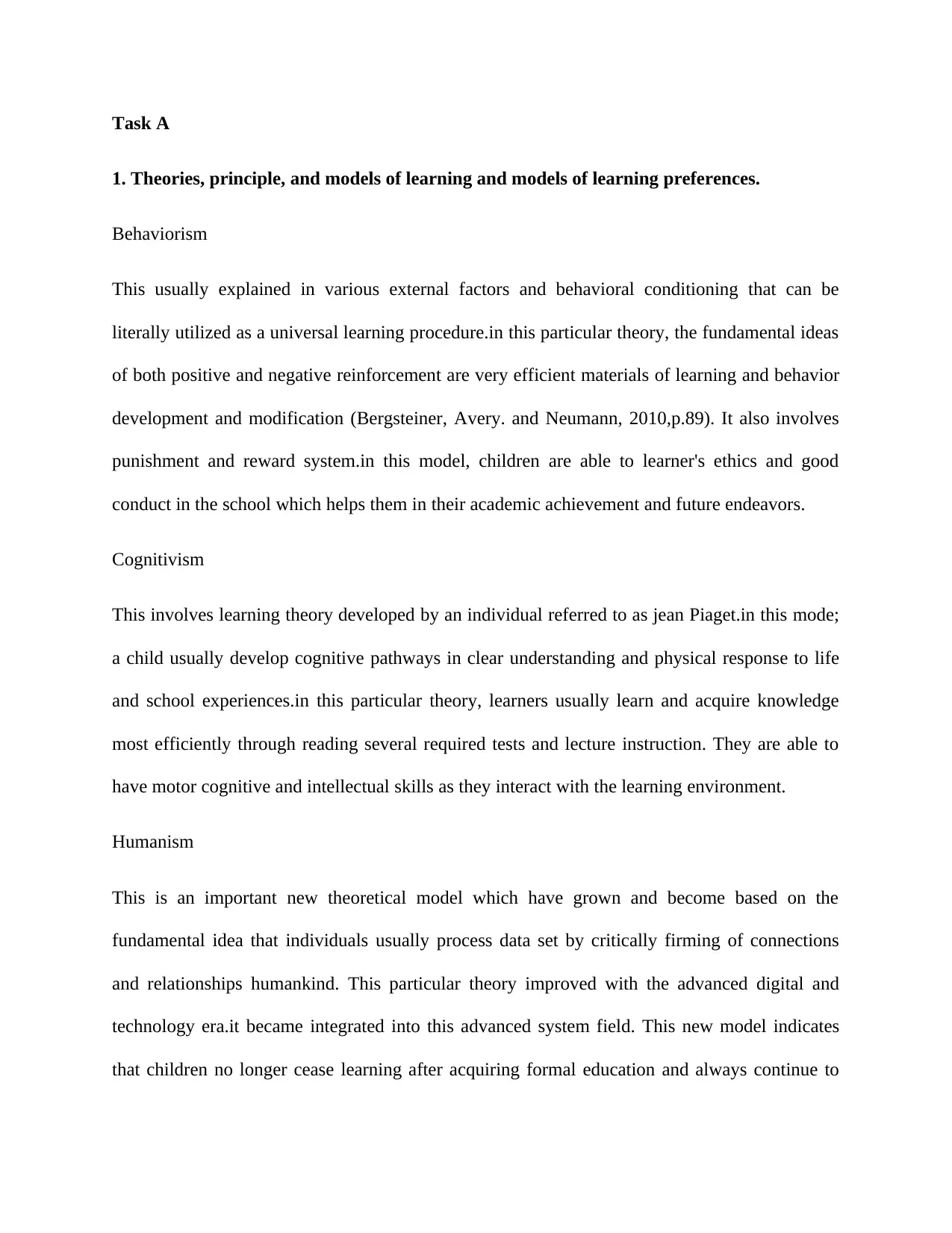
Task A
1. Theories, principle, and models of learning and models of learning preferences.
Behaviorism
This usually explained in various external factors and behavioral conditioning that can be
literally utilized as a universal learning procedure.in this particular theory, the fundamental ideas
of both positive and negative reinforcement are very efficient materials of learning and behavior
development and modification (Bergsteiner, Avery. and Neumann, 2010,p.89). It also involves
punishment and reward system.in this model, children are able to learner's ethics and good
conduct in the school which helps them in their academic achievement and future endeavors.
Cognitivism
This involves learning theory developed by an individual referred to as jean Piaget.in this mode;
a child usually develop cognitive pathways in clear understanding and physical response to life
and school experiences.in this particular theory, learners usually learn and acquire knowledge
most efficiently through reading several required tests and lecture instruction. They are able to
have motor cognitive and intellectual skills as they interact with the learning environment.
Humanism
This is an important new theoretical model which have grown and become based on the
fundamental idea that individuals usually process data set by critically firming of connections
and relationships humankind. This particular theory improved with the advanced digital and
technology era.it became integrated into this advanced system field. This new model indicates
that children no longer cease learning after acquiring formal education and always continue to
1. Theories, principle, and models of learning and models of learning preferences.
Behaviorism
This usually explained in various external factors and behavioral conditioning that can be
literally utilized as a universal learning procedure.in this particular theory, the fundamental ideas
of both positive and negative reinforcement are very efficient materials of learning and behavior
development and modification (Bergsteiner, Avery. and Neumann, 2010,p.89). It also involves
punishment and reward system.in this model, children are able to learner's ethics and good
conduct in the school which helps them in their academic achievement and future endeavors.
Cognitivism
This involves learning theory developed by an individual referred to as jean Piaget.in this mode;
a child usually develop cognitive pathways in clear understanding and physical response to life
and school experiences.in this particular theory, learners usually learn and acquire knowledge
most efficiently through reading several required tests and lecture instruction. They are able to
have motor cognitive and intellectual skills as they interact with the learning environment.
Humanism
This is an important new theoretical model which have grown and become based on the
fundamental idea that individuals usually process data set by critically firming of connections
and relationships humankind. This particular theory improved with the advanced digital and
technology era.it became integrated into this advanced system field. This new model indicates
that children no longer cease learning after acquiring formal education and always continue to
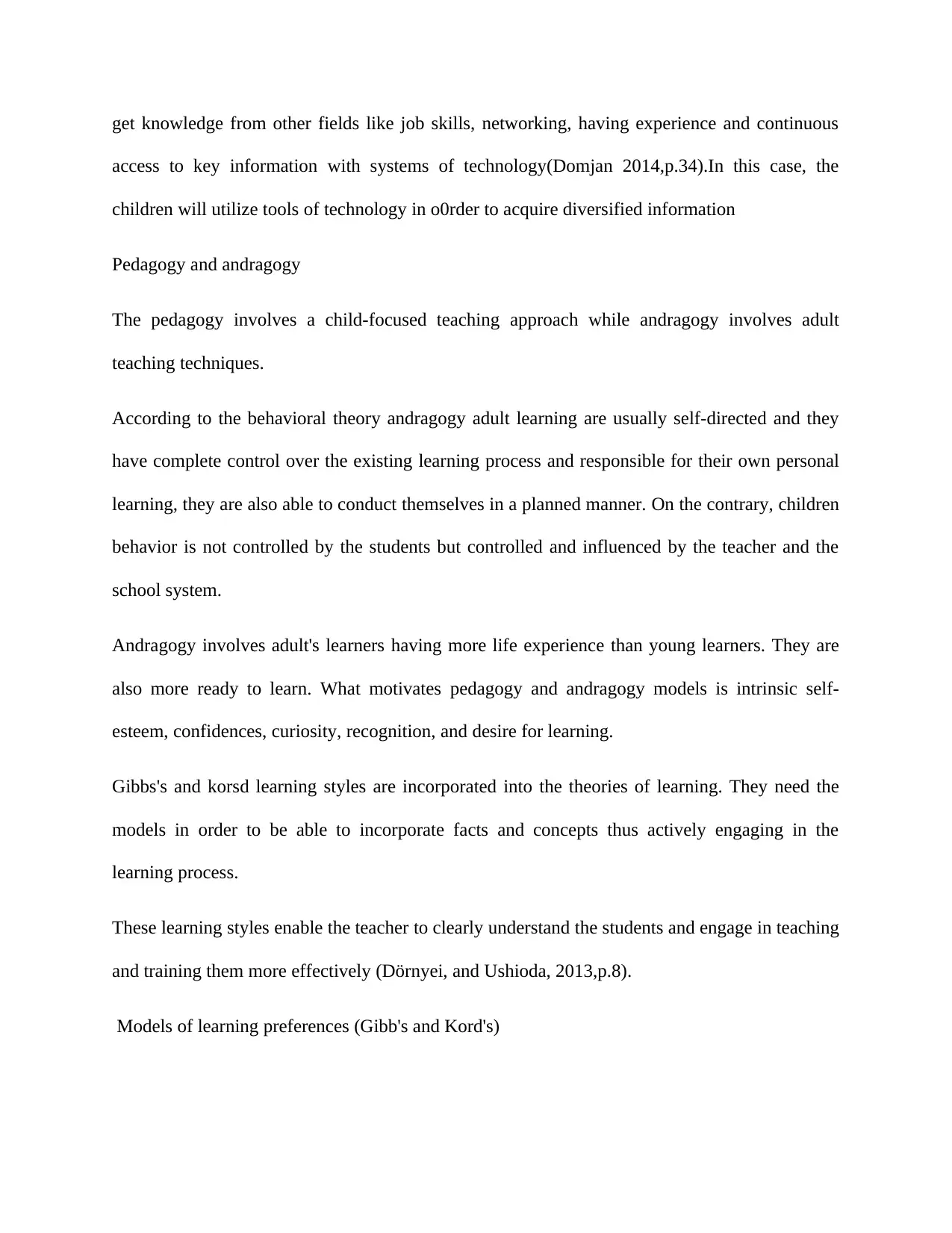
get knowledge from other fields like job skills, networking, having experience and continuous
access to key information with systems of technology(Domjan 2014,p.34).In this case, the
children will utilize tools of technology in o0rder to acquire diversified information
Pedagogy and andragogy
The pedagogy involves a child-focused teaching approach while andragogy involves adult
teaching techniques.
According to the behavioral theory andragogy adult learning are usually self-directed and they
have complete control over the existing learning process and responsible for their own personal
learning, they are also able to conduct themselves in a planned manner. On the contrary, children
behavior is not controlled by the students but controlled and influenced by the teacher and the
school system.
Andragogy involves adult's learners having more life experience than young learners. They are
also more ready to learn. What motivates pedagogy and andragogy models is intrinsic self-
esteem, confidences, curiosity, recognition, and desire for learning.
Gibbs's and korsd learning styles are incorporated into the theories of learning. They need the
models in order to be able to incorporate facts and concepts thus actively engaging in the
learning process.
These learning styles enable the teacher to clearly understand the students and engage in teaching
and training them more effectively (Dörnyei, and Ushioda, 2013,p.8).
Models of learning preferences (Gibb's and Kord's)
access to key information with systems of technology(Domjan 2014,p.34).In this case, the
children will utilize tools of technology in o0rder to acquire diversified information
Pedagogy and andragogy
The pedagogy involves a child-focused teaching approach while andragogy involves adult
teaching techniques.
According to the behavioral theory andragogy adult learning are usually self-directed and they
have complete control over the existing learning process and responsible for their own personal
learning, they are also able to conduct themselves in a planned manner. On the contrary, children
behavior is not controlled by the students but controlled and influenced by the teacher and the
school system.
Andragogy involves adult's learners having more life experience than young learners. They are
also more ready to learn. What motivates pedagogy and andragogy models is intrinsic self-
esteem, confidences, curiosity, recognition, and desire for learning.
Gibbs's and korsd learning styles are incorporated into the theories of learning. They need the
models in order to be able to incorporate facts and concepts thus actively engaging in the
learning process.
These learning styles enable the teacher to clearly understand the students and engage in teaching
and training them more effectively (Dörnyei, and Ushioda, 2013,p.8).
Models of learning preferences (Gibb's and Kord's)
⊘ This is a preview!⊘
Do you want full access?
Subscribe today to unlock all pages.

Trusted by 1+ million students worldwide
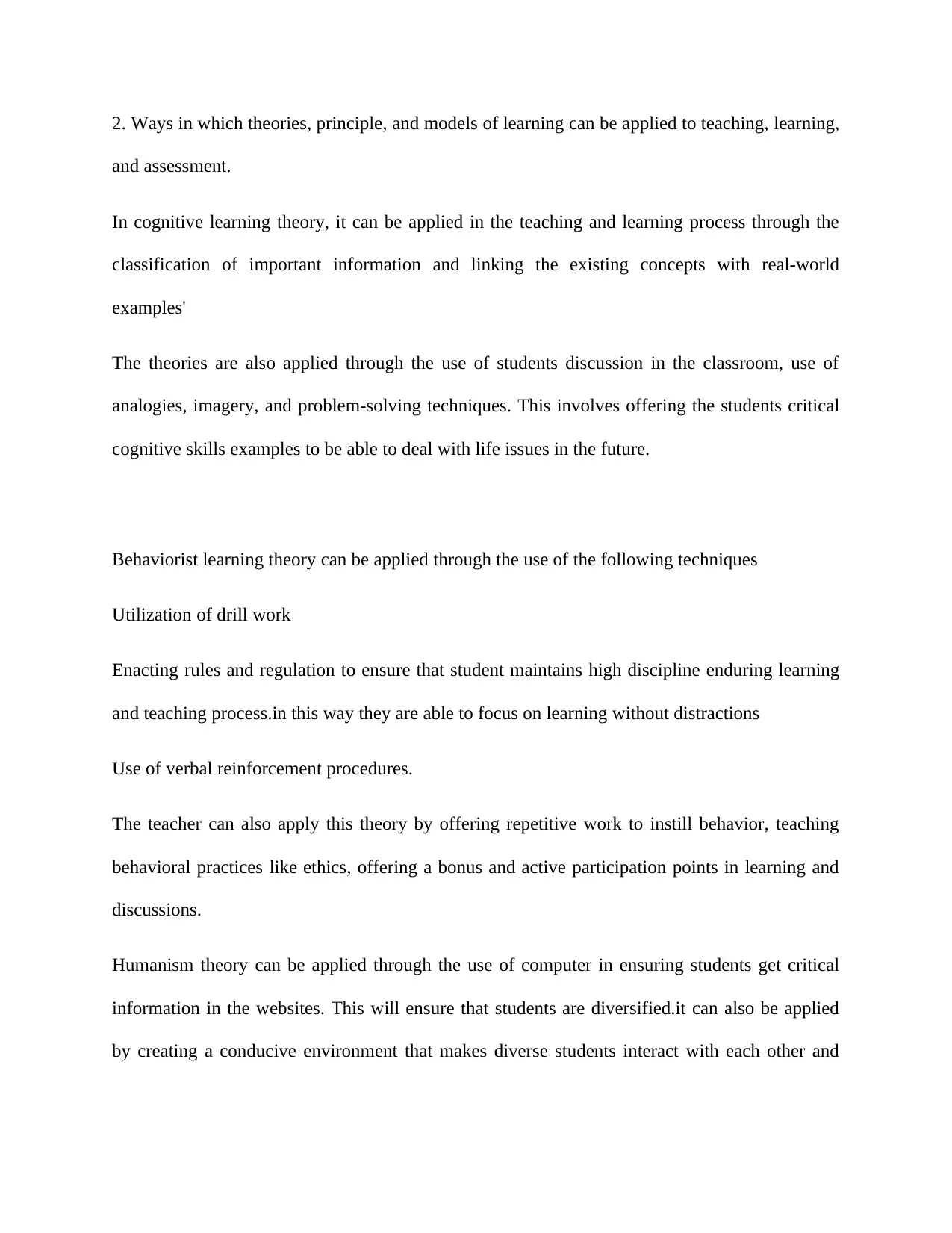
2. Ways in which theories, principle, and models of learning can be applied to teaching, learning,
and assessment.
In cognitive learning theory, it can be applied in the teaching and learning process through the
classification of important information and linking the existing concepts with real-world
examples'
The theories are also applied through the use of students discussion in the classroom, use of
analogies, imagery, and problem-solving techniques. This involves offering the students critical
cognitive skills examples to be able to deal with life issues in the future.
Behaviorist learning theory can be applied through the use of the following techniques
Utilization of drill work
Enacting rules and regulation to ensure that student maintains high discipline enduring learning
and teaching process.in this way they are able to focus on learning without distractions
Use of verbal reinforcement procedures.
The teacher can also apply this theory by offering repetitive work to instill behavior, teaching
behavioral practices like ethics, offering a bonus and active participation points in learning and
discussions.
Humanism theory can be applied through the use of computer in ensuring students get critical
information in the websites. This will ensure that students are diversified.it can also be applied
by creating a conducive environment that makes diverse students interact with each other and
and assessment.
In cognitive learning theory, it can be applied in the teaching and learning process through the
classification of important information and linking the existing concepts with real-world
examples'
The theories are also applied through the use of students discussion in the classroom, use of
analogies, imagery, and problem-solving techniques. This involves offering the students critical
cognitive skills examples to be able to deal with life issues in the future.
Behaviorist learning theory can be applied through the use of the following techniques
Utilization of drill work
Enacting rules and regulation to ensure that student maintains high discipline enduring learning
and teaching process.in this way they are able to focus on learning without distractions
Use of verbal reinforcement procedures.
The teacher can also apply this theory by offering repetitive work to instill behavior, teaching
behavioral practices like ethics, offering a bonus and active participation points in learning and
discussions.
Humanism theory can be applied through the use of computer in ensuring students get critical
information in the websites. This will ensure that students are diversified.it can also be applied
by creating a conducive environment that makes diverse students interact with each other and
Paraphrase This Document
Need a fresh take? Get an instant paraphrase of this document with our AI Paraphraser
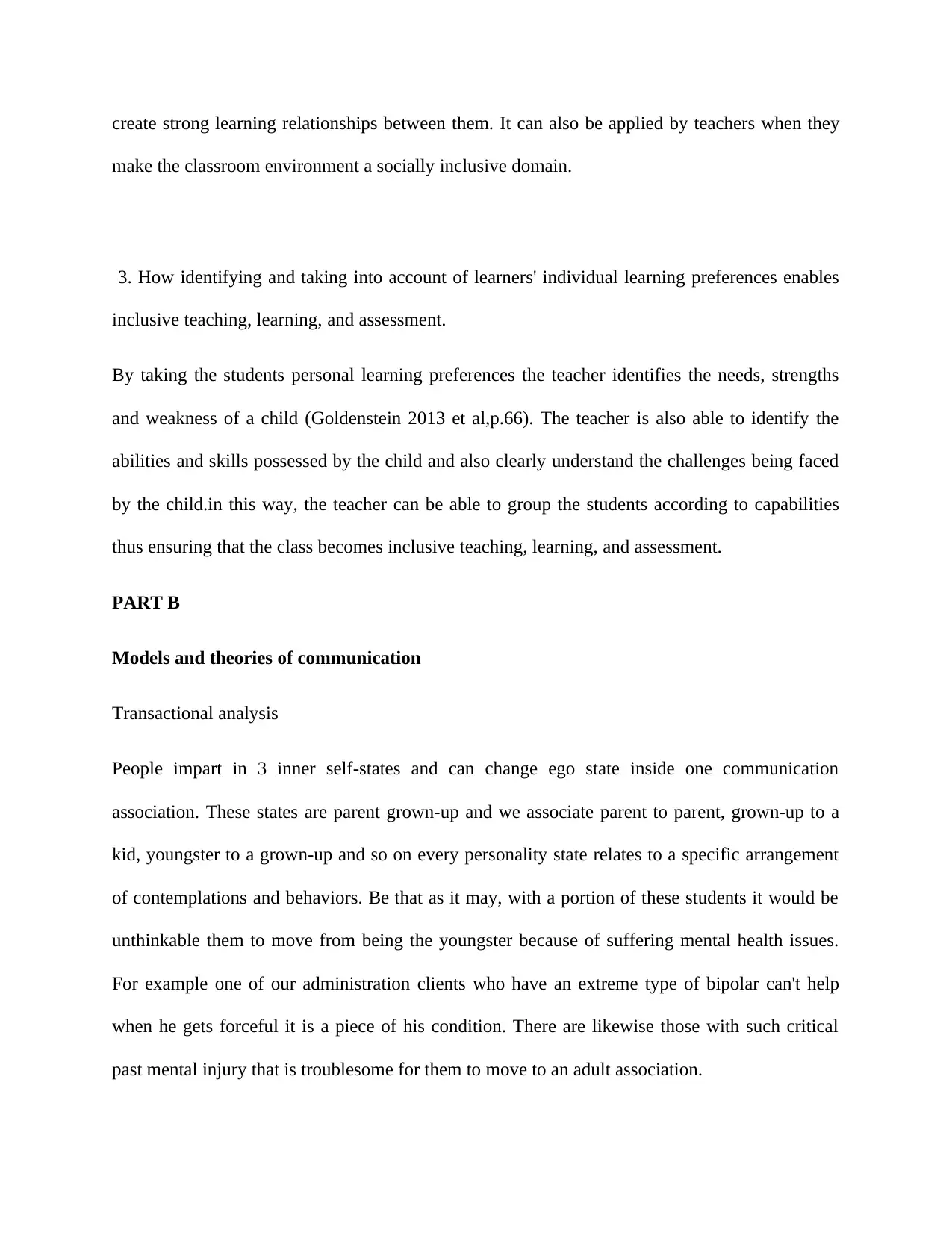
create strong learning relationships between them. It can also be applied by teachers when they
make the classroom environment a socially inclusive domain.
3. How identifying and taking into account of learners' individual learning preferences enables
inclusive teaching, learning, and assessment.
By taking the students personal learning preferences the teacher identifies the needs, strengths
and weakness of a child (Goldenstein 2013 et al,p.66). The teacher is also able to identify the
abilities and skills possessed by the child and also clearly understand the challenges being faced
by the child.in this way, the teacher can be able to group the students according to capabilities
thus ensuring that the class becomes inclusive teaching, learning, and assessment.
PART B
Models and theories of communication
Transactional analysis
People impart in 3 inner self-states and can change ego state inside one communication
association. These states are parent grown-up and we associate parent to parent, grown-up to a
kid, youngster to a grown-up and so on every personality state relates to a specific arrangement
of contemplations and behaviors. Be that as it may, with a portion of these students it would be
unthinkable them to move from being the youngster because of suffering mental health issues.
For example one of our administration clients who have an extreme type of bipolar can't help
when he gets forceful it is a piece of his condition. There are likewise those with such critical
past mental injury that is troublesome for them to move to an adult association.
make the classroom environment a socially inclusive domain.
3. How identifying and taking into account of learners' individual learning preferences enables
inclusive teaching, learning, and assessment.
By taking the students personal learning preferences the teacher identifies the needs, strengths
and weakness of a child (Goldenstein 2013 et al,p.66). The teacher is also able to identify the
abilities and skills possessed by the child and also clearly understand the challenges being faced
by the child.in this way, the teacher can be able to group the students according to capabilities
thus ensuring that the class becomes inclusive teaching, learning, and assessment.
PART B
Models and theories of communication
Transactional analysis
People impart in 3 inner self-states and can change ego state inside one communication
association. These states are parent grown-up and we associate parent to parent, grown-up to a
kid, youngster to a grown-up and so on every personality state relates to a specific arrangement
of contemplations and behaviors. Be that as it may, with a portion of these students it would be
unthinkable them to move from being the youngster because of suffering mental health issues.
For example one of our administration clients who have an extreme type of bipolar can't help
when he gets forceful it is a piece of his condition. There are likewise those with such critical
past mental injury that is troublesome for them to move to an adult association.
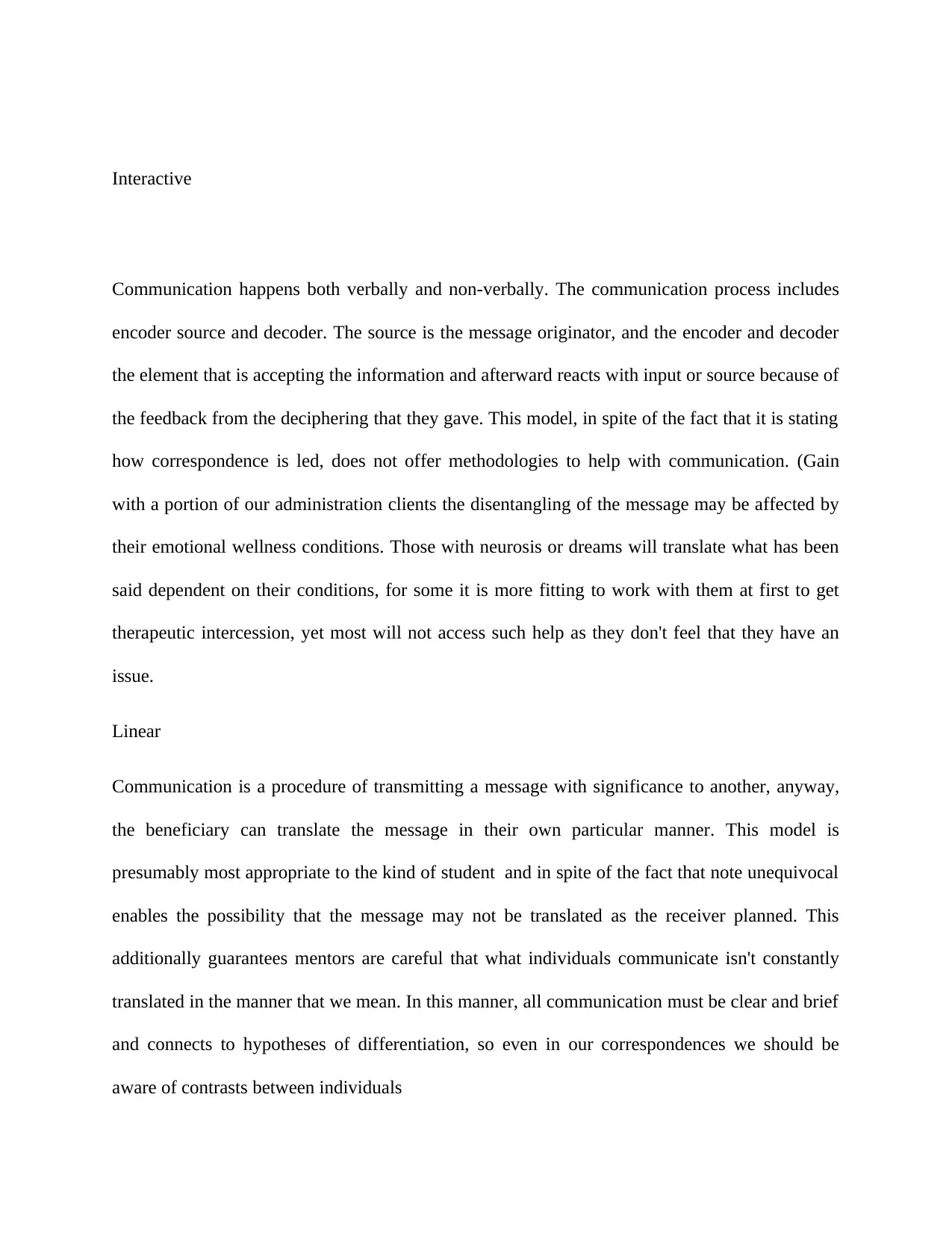
Interactive
Communication happens both verbally and non-verbally. The communication process includes
encoder source and decoder. The source is the message originator, and the encoder and decoder
the element that is accepting the information and afterward reacts with input or source because of
the feedback from the deciphering that they gave. This model, in spite of the fact that it is stating
how correspondence is led, does not offer methodologies to help with communication. (Gain
with a portion of our administration clients the disentangling of the message may be affected by
their emotional wellness conditions. Those with neurosis or dreams will translate what has been
said dependent on their conditions, for some it is more fitting to work with them at first to get
therapeutic intercession, yet most will not access such help as they don't feel that they have an
issue.
Linear
Communication is a procedure of transmitting a message with significance to another, anyway,
the beneficiary can translate the message in their own particular manner. This model is
presumably most appropriate to the kind of student and in spite of the fact that note unequivocal
enables the possibility that the message may not be translated as the receiver planned. This
additionally guarantees mentors are careful that what individuals communicate isn't constantly
translated in the manner that we mean. In this manner, all communication must be clear and brief
and connects to hypotheses of differentiation, so even in our correspondences we should be
aware of contrasts between individuals
Communication happens both verbally and non-verbally. The communication process includes
encoder source and decoder. The source is the message originator, and the encoder and decoder
the element that is accepting the information and afterward reacts with input or source because of
the feedback from the deciphering that they gave. This model, in spite of the fact that it is stating
how correspondence is led, does not offer methodologies to help with communication. (Gain
with a portion of our administration clients the disentangling of the message may be affected by
their emotional wellness conditions. Those with neurosis or dreams will translate what has been
said dependent on their conditions, for some it is more fitting to work with them at first to get
therapeutic intercession, yet most will not access such help as they don't feel that they have an
issue.
Linear
Communication is a procedure of transmitting a message with significance to another, anyway,
the beneficiary can translate the message in their own particular manner. This model is
presumably most appropriate to the kind of student and in spite of the fact that note unequivocal
enables the possibility that the message may not be translated as the receiver planned. This
additionally guarantees mentors are careful that what individuals communicate isn't constantly
translated in the manner that we mean. In this manner, all communication must be clear and brief
and connects to hypotheses of differentiation, so even in our correspondences we should be
aware of contrasts between individuals
⊘ This is a preview!⊘
Do you want full access?
Subscribe today to unlock all pages.

Trusted by 1+ million students worldwide
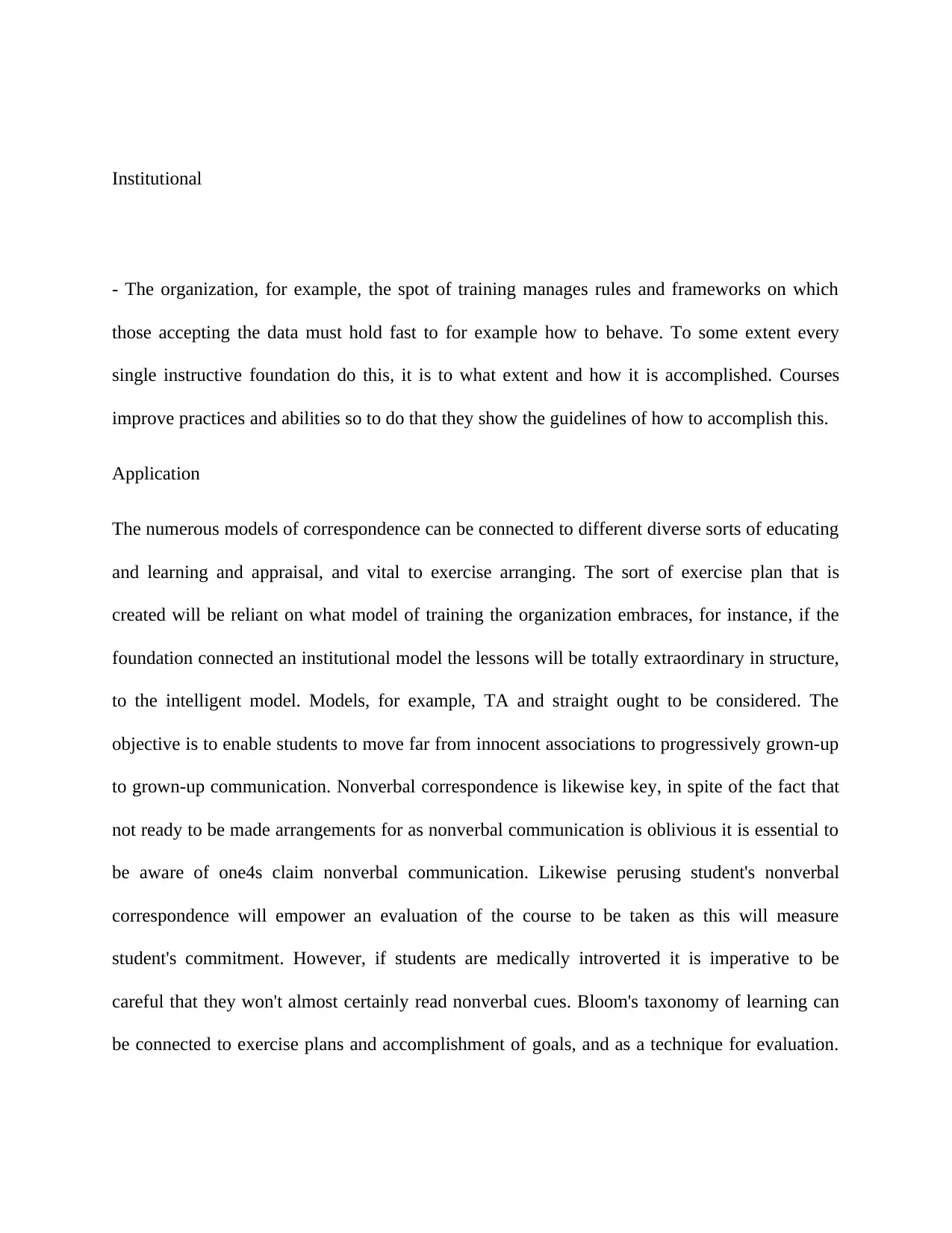
Institutional
- The organization, for example, the spot of training manages rules and frameworks on which
those accepting the data must hold fast to for example how to behave. To some extent every
single instructive foundation do this, it is to what extent and how it is accomplished. Courses
improve practices and abilities so to do that they show the guidelines of how to accomplish this.
Application
The numerous models of correspondence can be connected to different diverse sorts of educating
and learning and appraisal, and vital to exercise arranging. The sort of exercise plan that is
created will be reliant on what model of training the organization embraces, for instance, if the
foundation connected an institutional model the lessons will be totally extraordinary in structure,
to the intelligent model. Models, for example, TA and straight ought to be considered. The
objective is to enable students to move far from innocent associations to progressively grown-up
to grown-up communication. Nonverbal correspondence is likewise key, in spite of the fact that
not ready to be made arrangements for as nonverbal communication is oblivious it is essential to
be aware of one4s claim nonverbal communication. Likewise perusing student's nonverbal
correspondence will empower an evaluation of the course to be taken as this will measure
student's commitment. However, if students are medically introverted it is imperative to be
careful that they won't almost certainly read nonverbal cues. Bloom's taxonomy of learning can
be connected to exercise plans and accomplishment of goals, and as a technique for evaluation.
- The organization, for example, the spot of training manages rules and frameworks on which
those accepting the data must hold fast to for example how to behave. To some extent every
single instructive foundation do this, it is to what extent and how it is accomplished. Courses
improve practices and abilities so to do that they show the guidelines of how to accomplish this.
Application
The numerous models of correspondence can be connected to different diverse sorts of educating
and learning and appraisal, and vital to exercise arranging. The sort of exercise plan that is
created will be reliant on what model of training the organization embraces, for instance, if the
foundation connected an institutional model the lessons will be totally extraordinary in structure,
to the intelligent model. Models, for example, TA and straight ought to be considered. The
objective is to enable students to move far from innocent associations to progressively grown-up
to grown-up communication. Nonverbal correspondence is likewise key, in spite of the fact that
not ready to be made arrangements for as nonverbal communication is oblivious it is essential to
be aware of one4s claim nonverbal communication. Likewise perusing student's nonverbal
correspondence will empower an evaluation of the course to be taken as this will measure
student's commitment. However, if students are medically introverted it is imperative to be
careful that they won't almost certainly read nonverbal cues. Bloom's taxonomy of learning can
be connected to exercise plans and accomplishment of goals, and as a technique for evaluation.
Paraphrase This Document
Need a fresh take? Get an instant paraphrase of this document with our AI Paraphraser
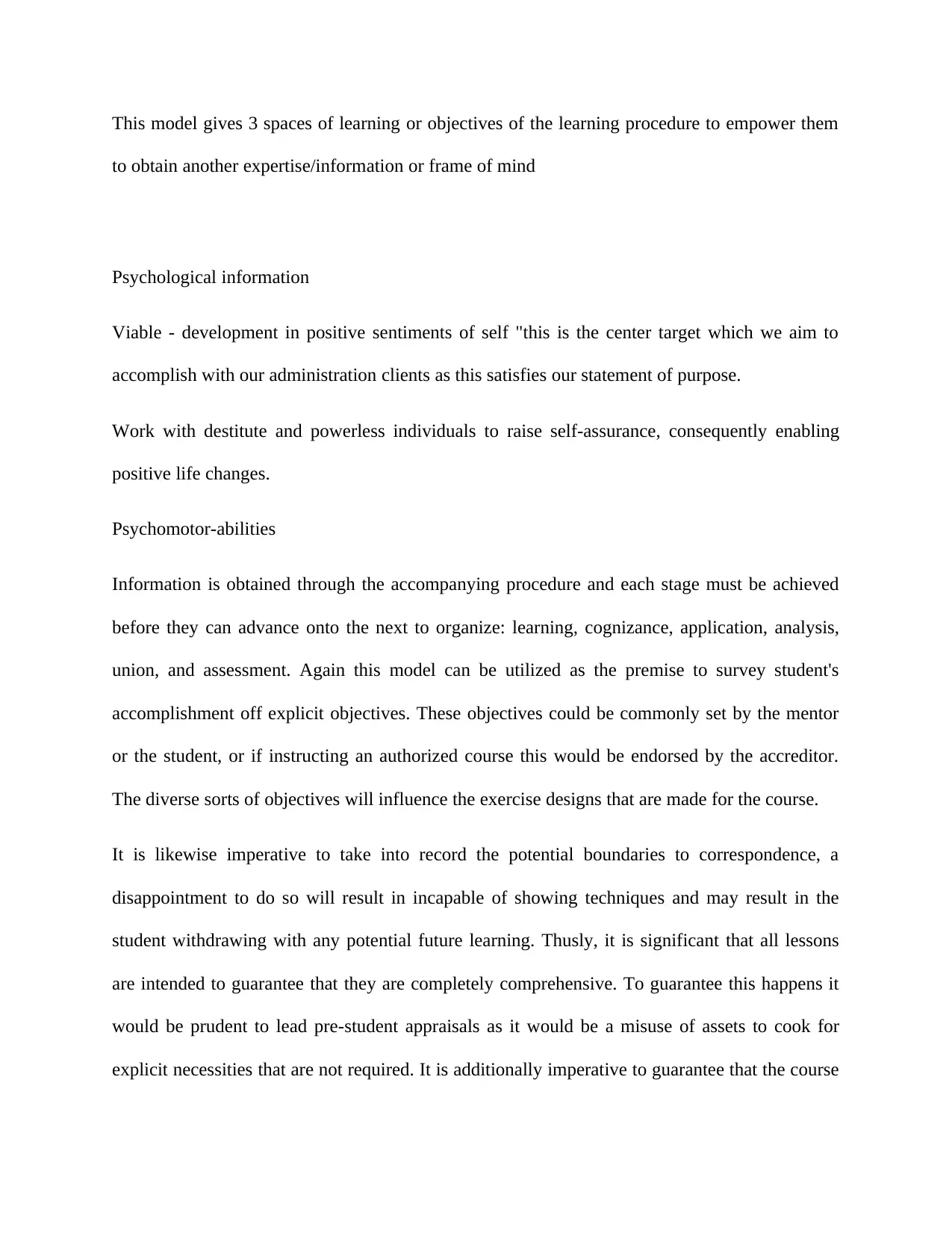
This model gives 3 spaces of learning or objectives of the learning procedure to empower them
to obtain another expertise/information or frame of mind
Psychological information
Viable - development in positive sentiments of self "this is the center target which we aim to
accomplish with our administration clients as this satisfies our statement of purpose.
Work with destitute and powerless individuals to raise self-assurance, consequently enabling
positive life changes.
Psychomotor-abilities
Information is obtained through the accompanying procedure and each stage must be achieved
before they can advance onto the next to organize: learning, cognizance, application, analysis,
union, and assessment. Again this model can be utilized as the premise to survey student's
accomplishment off explicit objectives. These objectives could be commonly set by the mentor
or the student, or if instructing an authorized course this would be endorsed by the accreditor.
The diverse sorts of objectives will influence the exercise designs that are made for the course.
It is likewise imperative to take into record the potential boundaries to correspondence, a
disappointment to do so will result in incapable of showing techniques and may result in the
student withdrawing with any potential future learning. Thusly, it is significant that all lessons
are intended to guarantee that they are completely comprehensive. To guarantee this happens it
would be prudent to lead pre-student appraisals as it would be a misuse of assets to cook for
explicit necessities that are not required. It is additionally imperative to guarantee that the course
to obtain another expertise/information or frame of mind
Psychological information
Viable - development in positive sentiments of self "this is the center target which we aim to
accomplish with our administration clients as this satisfies our statement of purpose.
Work with destitute and powerless individuals to raise self-assurance, consequently enabling
positive life changes.
Psychomotor-abilities
Information is obtained through the accompanying procedure and each stage must be achieved
before they can advance onto the next to organize: learning, cognizance, application, analysis,
union, and assessment. Again this model can be utilized as the premise to survey student's
accomplishment off explicit objectives. These objectives could be commonly set by the mentor
or the student, or if instructing an authorized course this would be endorsed by the accreditor.
The diverse sorts of objectives will influence the exercise designs that are made for the course.
It is likewise imperative to take into record the potential boundaries to correspondence, a
disappointment to do so will result in incapable of showing techniques and may result in the
student withdrawing with any potential future learning. Thusly, it is significant that all lessons
are intended to guarantee that they are completely comprehensive. To guarantee this happens it
would be prudent to lead pre-student appraisals as it would be a misuse of assets to cook for
explicit necessities that are not required. It is additionally imperative to guarantee that the course
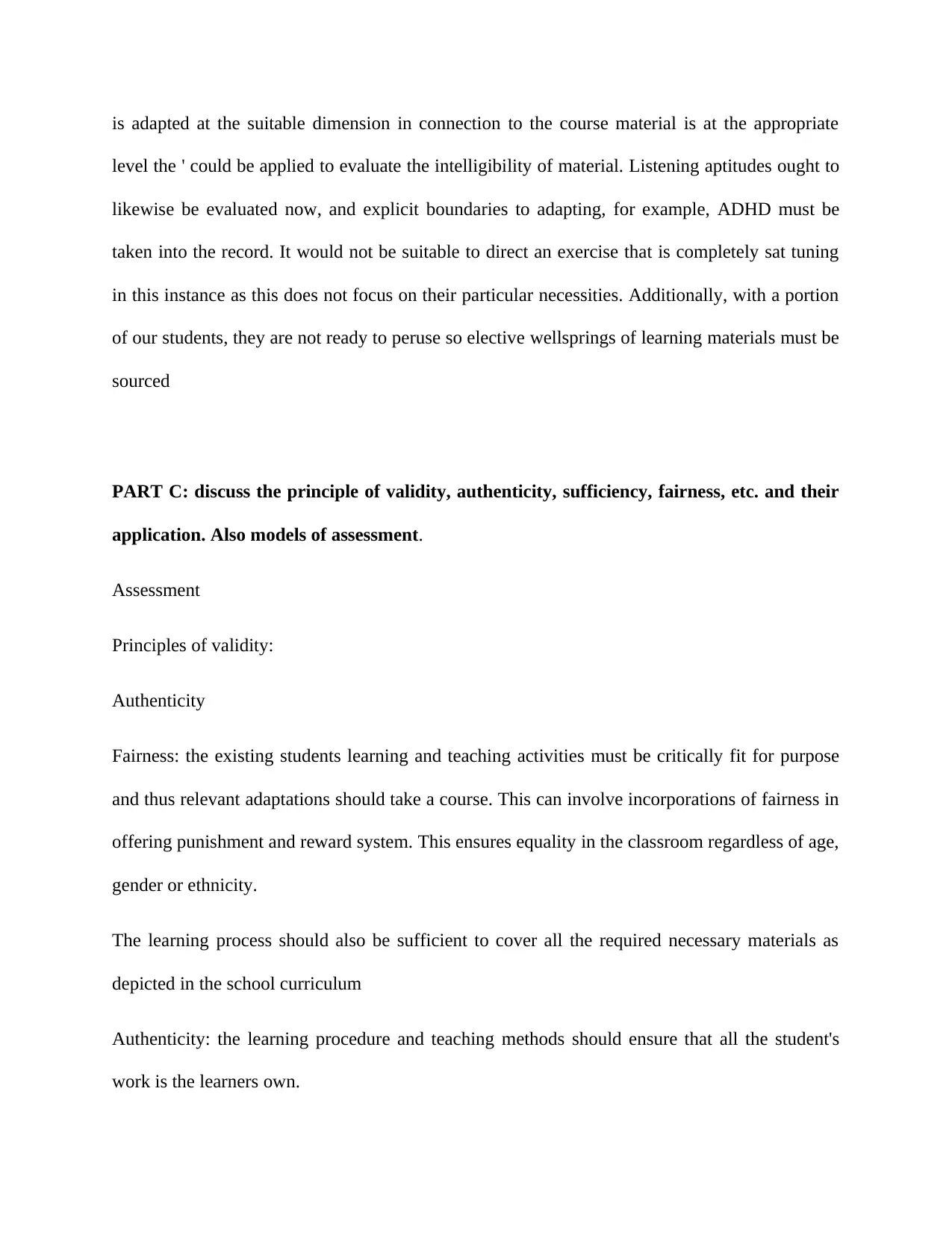
is adapted at the suitable dimension in connection to the course material is at the appropriate
level the ' could be applied to evaluate the intelligibility of material. Listening aptitudes ought to
likewise be evaluated now, and explicit boundaries to adapting, for example, ADHD must be
taken into the record. It would not be suitable to direct an exercise that is completely sat tuning
in this instance as this does not focus on their particular necessities. Additionally, with a portion
of our students, they are not ready to peruse so elective wellsprings of learning materials must be
sourced
PART C: discuss the principle of validity, authenticity, sufficiency, fairness, etc. and their
application. Also models of assessment.
Assessment
Principles of validity:
Authenticity
Fairness: the existing students learning and teaching activities must be critically fit for purpose
and thus relevant adaptations should take a course. This can involve incorporations of fairness in
offering punishment and reward system. This ensures equality in the classroom regardless of age,
gender or ethnicity.
The learning process should also be sufficient to cover all the required necessary materials as
depicted in the school curriculum
Authenticity: the learning procedure and teaching methods should ensure that all the student's
work is the learners own.
level the ' could be applied to evaluate the intelligibility of material. Listening aptitudes ought to
likewise be evaluated now, and explicit boundaries to adapting, for example, ADHD must be
taken into the record. It would not be suitable to direct an exercise that is completely sat tuning
in this instance as this does not focus on their particular necessities. Additionally, with a portion
of our students, they are not ready to peruse so elective wellsprings of learning materials must be
sourced
PART C: discuss the principle of validity, authenticity, sufficiency, fairness, etc. and their
application. Also models of assessment.
Assessment
Principles of validity:
Authenticity
Fairness: the existing students learning and teaching activities must be critically fit for purpose
and thus relevant adaptations should take a course. This can involve incorporations of fairness in
offering punishment and reward system. This ensures equality in the classroom regardless of age,
gender or ethnicity.
The learning process should also be sufficient to cover all the required necessary materials as
depicted in the school curriculum
Authenticity: the learning procedure and teaching methods should ensure that all the student's
work is the learners own.
⊘ This is a preview!⊘
Do you want full access?
Subscribe today to unlock all pages.

Trusted by 1+ million students worldwide
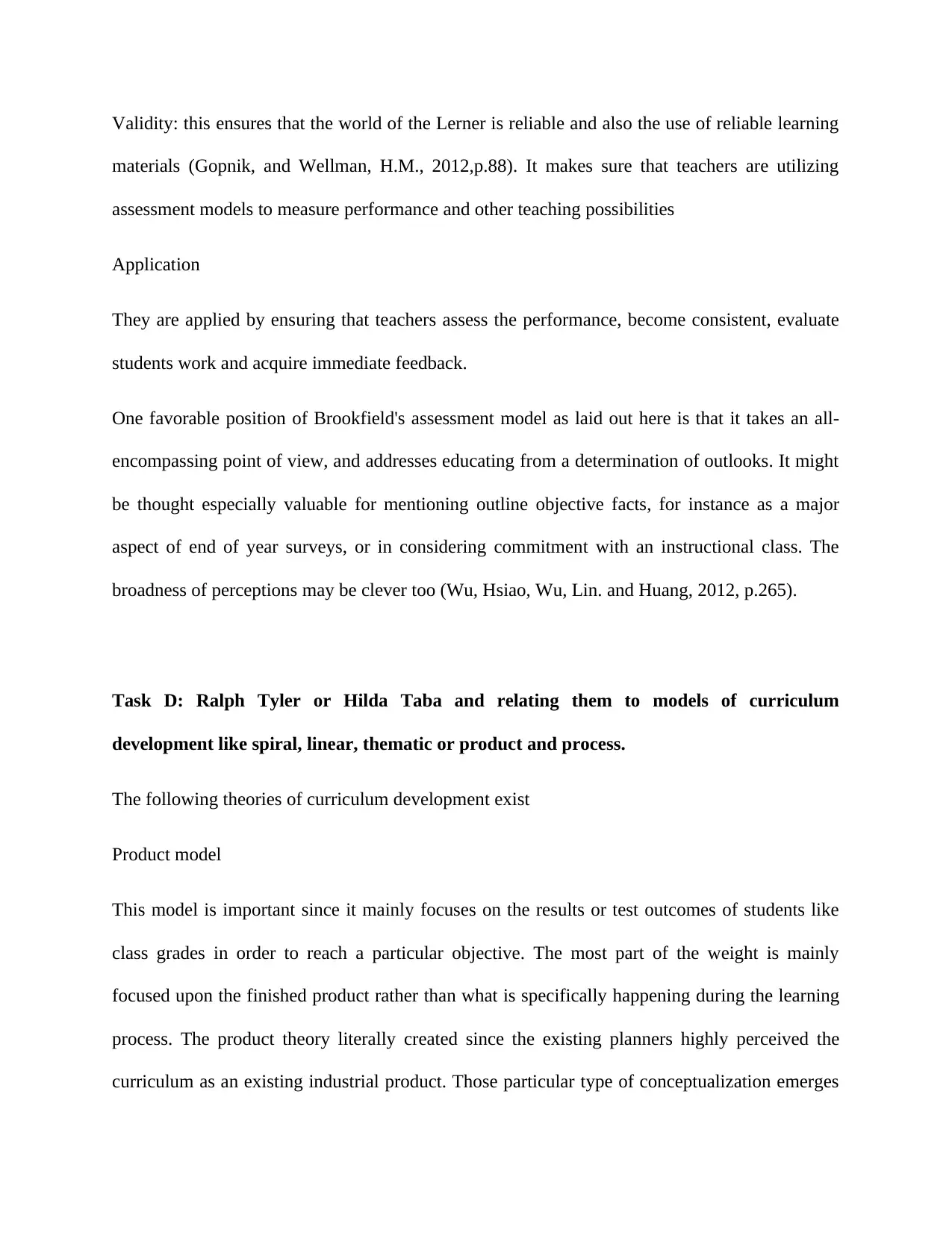
Validity: this ensures that the world of the Lerner is reliable and also the use of reliable learning
materials (Gopnik, and Wellman, H.M., 2012,p.88). It makes sure that teachers are utilizing
assessment models to measure performance and other teaching possibilities
Application
They are applied by ensuring that teachers assess the performance, become consistent, evaluate
students work and acquire immediate feedback.
One favorable position of Brookfield's assessment model as laid out here is that it takes an all-
encompassing point of view, and addresses educating from a determination of outlooks. It might
be thought especially valuable for mentioning outline objective facts, for instance as a major
aspect of end of year surveys, or in considering commitment with an instructional class. The
broadness of perceptions may be clever too (Wu, Hsiao, Wu, Lin. and Huang, 2012, p.265).
Task D: Ralph Tyler or Hilda Taba and relating them to models of curriculum
development like spiral, linear, thematic or product and process.
The following theories of curriculum development exist
Product model
This model is important since it mainly focuses on the results or test outcomes of students like
class grades in order to reach a particular objective. The most part of the weight is mainly
focused upon the finished product rather than what is specifically happening during the learning
process. The product theory literally created since the existing planners highly perceived the
curriculum as an existing industrial product. Those particular type of conceptualization emerges
materials (Gopnik, and Wellman, H.M., 2012,p.88). It makes sure that teachers are utilizing
assessment models to measure performance and other teaching possibilities
Application
They are applied by ensuring that teachers assess the performance, become consistent, evaluate
students work and acquire immediate feedback.
One favorable position of Brookfield's assessment model as laid out here is that it takes an all-
encompassing point of view, and addresses educating from a determination of outlooks. It might
be thought especially valuable for mentioning outline objective facts, for instance as a major
aspect of end of year surveys, or in considering commitment with an instructional class. The
broadness of perceptions may be clever too (Wu, Hsiao, Wu, Lin. and Huang, 2012, p.265).
Task D: Ralph Tyler or Hilda Taba and relating them to models of curriculum
development like spiral, linear, thematic or product and process.
The following theories of curriculum development exist
Product model
This model is important since it mainly focuses on the results or test outcomes of students like
class grades in order to reach a particular objective. The most part of the weight is mainly
focused upon the finished product rather than what is specifically happening during the learning
process. The product theory literally created since the existing planners highly perceived the
curriculum as an existing industrial product. Those particular type of conceptualization emerges
Paraphrase This Document
Need a fresh take? Get an instant paraphrase of this document with our AI Paraphraser
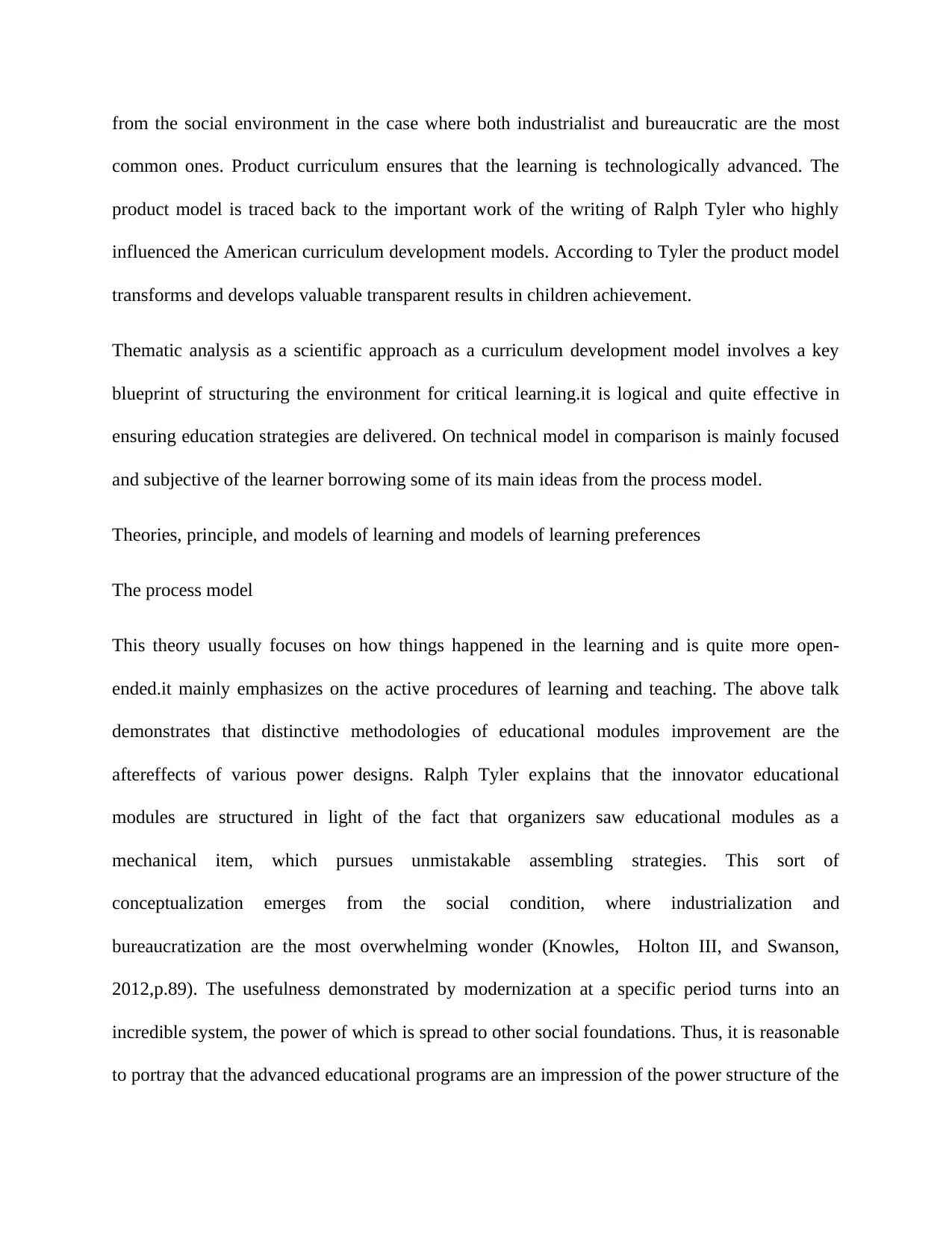
from the social environment in the case where both industrialist and bureaucratic are the most
common ones. Product curriculum ensures that the learning is technologically advanced. The
product model is traced back to the important work of the writing of Ralph Tyler who highly
influenced the American curriculum development models. According to Tyler the product model
transforms and develops valuable transparent results in children achievement.
Thematic analysis as a scientific approach as a curriculum development model involves a key
blueprint of structuring the environment for critical learning.it is logical and quite effective in
ensuring education strategies are delivered. On technical model in comparison is mainly focused
and subjective of the learner borrowing some of its main ideas from the process model.
Theories, principle, and models of learning and models of learning preferences
The process model
This theory usually focuses on how things happened in the learning and is quite more open-
ended.it mainly emphasizes on the active procedures of learning and teaching. The above talk
demonstrates that distinctive methodologies of educational modules improvement are the
aftereffects of various power designs. Ralph Tyler explains that the innovator educational
modules are structured in light of the fact that organizers saw educational modules as a
mechanical item, which pursues unmistakable assembling strategies. This sort of
conceptualization emerges from the social condition, where industrialization and
bureaucratization are the most overwhelming wonder (Knowles, Holton III, and Swanson,
2012,p.89). The usefulness demonstrated by modernization at a specific period turns into an
incredible system, the power of which is spread to other social foundations. Thus, it is reasonable
to portray that the advanced educational programs are an impression of the power structure of the
common ones. Product curriculum ensures that the learning is technologically advanced. The
product model is traced back to the important work of the writing of Ralph Tyler who highly
influenced the American curriculum development models. According to Tyler the product model
transforms and develops valuable transparent results in children achievement.
Thematic analysis as a scientific approach as a curriculum development model involves a key
blueprint of structuring the environment for critical learning.it is logical and quite effective in
ensuring education strategies are delivered. On technical model in comparison is mainly focused
and subjective of the learner borrowing some of its main ideas from the process model.
Theories, principle, and models of learning and models of learning preferences
The process model
This theory usually focuses on how things happened in the learning and is quite more open-
ended.it mainly emphasizes on the active procedures of learning and teaching. The above talk
demonstrates that distinctive methodologies of educational modules improvement are the
aftereffects of various power designs. Ralph Tyler explains that the innovator educational
modules are structured in light of the fact that organizers saw educational modules as a
mechanical item, which pursues unmistakable assembling strategies. This sort of
conceptualization emerges from the social condition, where industrialization and
bureaucratization are the most overwhelming wonder (Knowles, Holton III, and Swanson,
2012,p.89). The usefulness demonstrated by modernization at a specific period turns into an
incredible system, the power of which is spread to other social foundations. Thus, it is reasonable
to portray that the advanced educational programs are an impression of the power structure of the
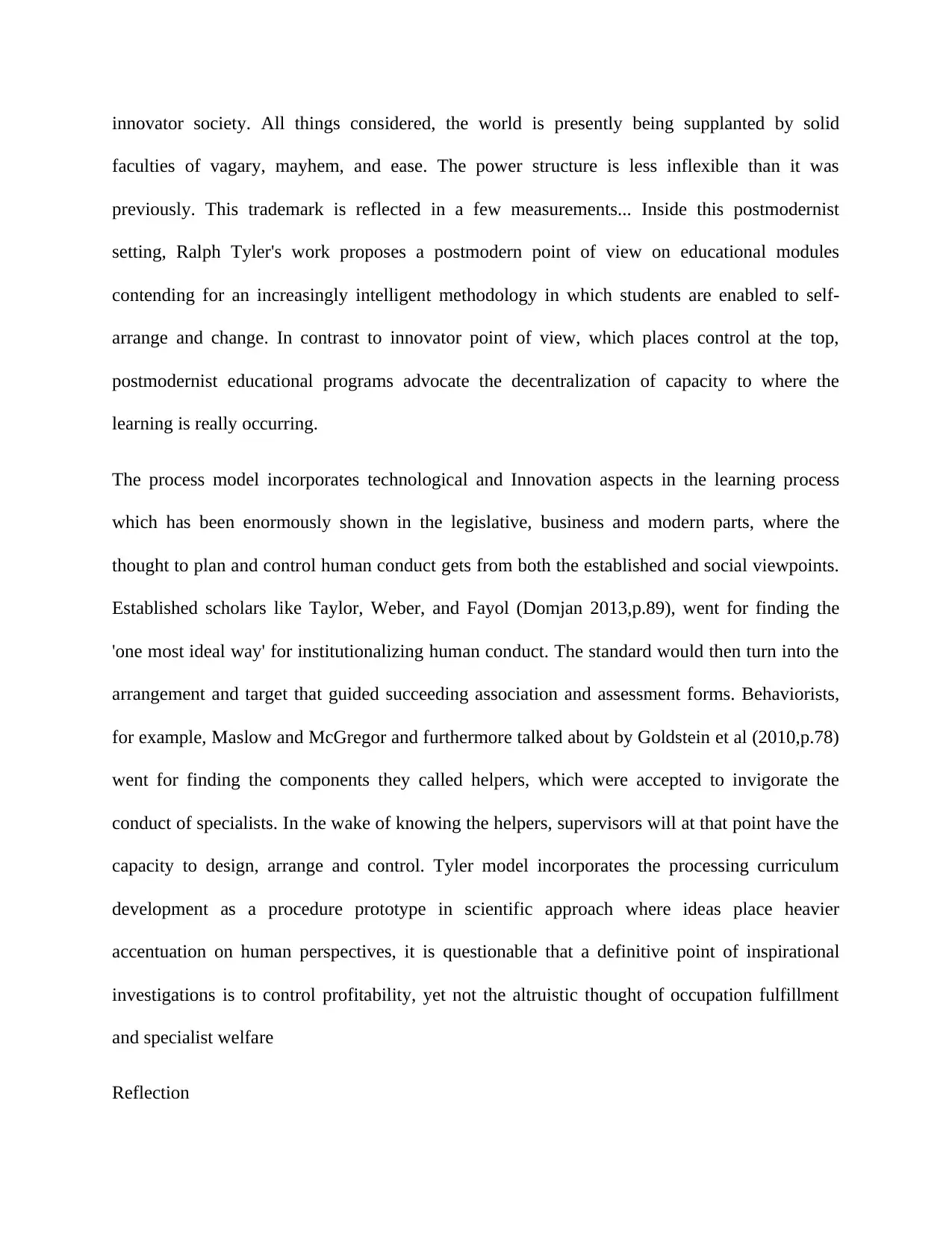
innovator society. All things considered, the world is presently being supplanted by solid
faculties of vagary, mayhem, and ease. The power structure is less inflexible than it was
previously. This trademark is reflected in a few measurements... Inside this postmodernist
setting, Ralph Tyler's work proposes a postmodern point of view on educational modules
contending for an increasingly intelligent methodology in which students are enabled to self-
arrange and change. In contrast to innovator point of view, which places control at the top,
postmodernist educational programs advocate the decentralization of capacity to where the
learning is really occurring.
The process model incorporates technological and Innovation aspects in the learning process
which has been enormously shown in the legislative, business and modern parts, where the
thought to plan and control human conduct gets from both the established and social viewpoints.
Established scholars like Taylor, Weber, and Fayol (Domjan 2013,p.89), went for finding the
'one most ideal way' for institutionalizing human conduct. The standard would then turn into the
arrangement and target that guided succeeding association and assessment forms. Behaviorists,
for example, Maslow and McGregor and furthermore talked about by Goldstein et al (2010,p.78)
went for finding the components they called helpers, which were accepted to invigorate the
conduct of specialists. In the wake of knowing the helpers, supervisors will at that point have the
capacity to design, arrange and control. Tyler model incorporates the processing curriculum
development as a procedure prototype in scientific approach where ideas place heavier
accentuation on human perspectives, it is questionable that a definitive point of inspirational
investigations is to control profitability, yet not the altruistic thought of occupation fulfillment
and specialist welfare
Reflection
faculties of vagary, mayhem, and ease. The power structure is less inflexible than it was
previously. This trademark is reflected in a few measurements... Inside this postmodernist
setting, Ralph Tyler's work proposes a postmodern point of view on educational modules
contending for an increasingly intelligent methodology in which students are enabled to self-
arrange and change. In contrast to innovator point of view, which places control at the top,
postmodernist educational programs advocate the decentralization of capacity to where the
learning is really occurring.
The process model incorporates technological and Innovation aspects in the learning process
which has been enormously shown in the legislative, business and modern parts, where the
thought to plan and control human conduct gets from both the established and social viewpoints.
Established scholars like Taylor, Weber, and Fayol (Domjan 2013,p.89), went for finding the
'one most ideal way' for institutionalizing human conduct. The standard would then turn into the
arrangement and target that guided succeeding association and assessment forms. Behaviorists,
for example, Maslow and McGregor and furthermore talked about by Goldstein et al (2010,p.78)
went for finding the components they called helpers, which were accepted to invigorate the
conduct of specialists. In the wake of knowing the helpers, supervisors will at that point have the
capacity to design, arrange and control. Tyler model incorporates the processing curriculum
development as a procedure prototype in scientific approach where ideas place heavier
accentuation on human perspectives, it is questionable that a definitive point of inspirational
investigations is to control profitability, yet not the altruistic thought of occupation fulfillment
and specialist welfare
Reflection
⊘ This is a preview!⊘
Do you want full access?
Subscribe today to unlock all pages.

Trusted by 1+ million students worldwide
1 out of 20
Related Documents
Your All-in-One AI-Powered Toolkit for Academic Success.
+13062052269
info@desklib.com
Available 24*7 on WhatsApp / Email
![[object Object]](/_next/static/media/star-bottom.7253800d.svg)
Unlock your academic potential
Copyright © 2020–2025 A2Z Services. All Rights Reserved. Developed and managed by ZUCOL.





